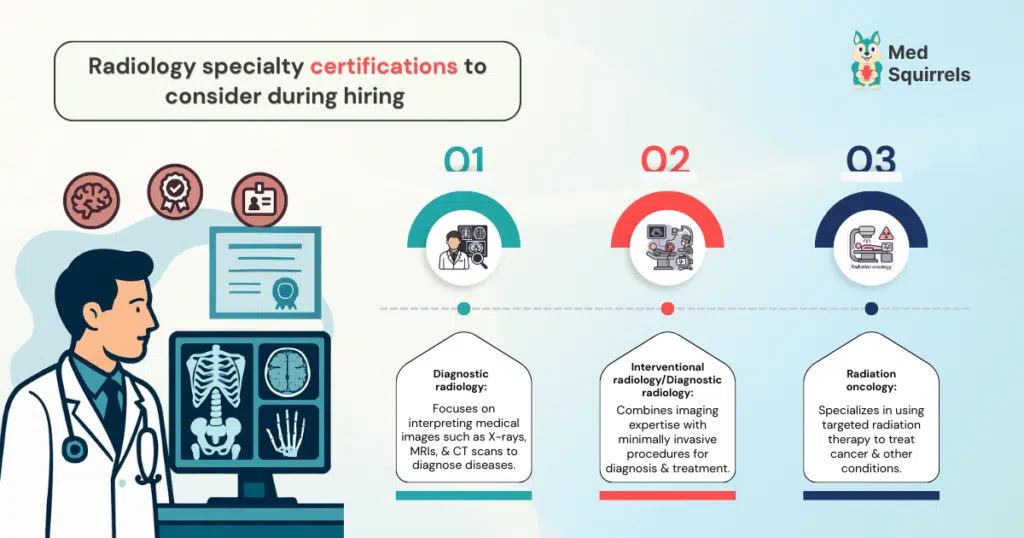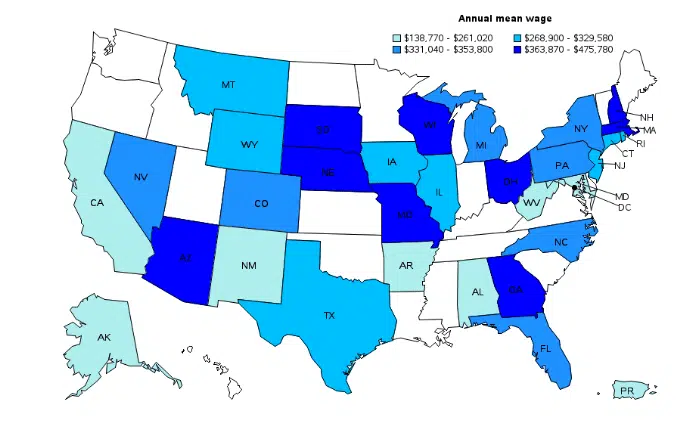How to hire radiologists specialized in MRI & CT imaging

When diagnostic imaging reliability is crucial to your service provision, learning how to hire a radiologist will be your top priority before you recruit. Radiologists specializing in MRI and CT bring advanced training that enhances diagnosis speed, clinical accuracy, and operational efficiency.
Whether you are a hospital radiology department or an outpatient imaging center, your hiring process must be tailored to meet the modality-specific needs of your department. This blog will help facilities like yours realign hiring practices to meet today’s imaging demands.
You must also stay competitive in a market where subspecialists are in high demand. Thoughtful recruitment not only saves costs but boosts long-term service quality and team satisfaction. When you plan to hire a radiologist for a healthcare facility, consider flexible staffing models, such as short-term contracts or full-time placements, to meet your specific caseloads, patient volumes, and scheduling gaps without compromising quality.
Also read: The role of flexible staffing models in modern healthcare
Assess imaging volume and define the radiologist’s role
Before considering how to hire a radiologist , as a recruiter, you must evaluate your facility’s imaging volume and service model. Break down MRI and CT scan volumes by weekday, modality, and urgency to determine if you need generalists or subspecialists. If your center is expanding to include more neuro or musculoskeletal MRIs or managing high-trauma CT volume, role clarity becomes vital.
Consider whether you will need weekend or evening coverage, and if teleradiology can support lower-volume shifts. A well-defined job role enables more precise and effective radiologist recruitment.
Here are some areas to assess when shaping role expectations:
- MRI vs. CT daily case load
- Percentage of advanced subspecialty reads (e.g., MSK MRI, Cardiac CT)
- On-site vs. remote interpretation needs
- Coverage gaps for evenings or weekends
Confirm certifications and subspecialty credentials
A crucial part of staffing radiologists for MRI and CT is verifying that candidates meet professional and legal requirements. Ensure the radiologist holds current board certification through ABR or AOBR and is licensed in your state.
Prioritize subspecialty fellowship training in MRI or CT, especially in domains like neuroimaging, MSK, or cardiac imaging. Do not overlook malpractice coverage or continuing medical education records. A rigorous credential check helps ensure quality care and a smooth onboarding process.
Use this checklist to streamline your credential verification process:
- ABR/AOBR board certification
- Active state licensure
- Fellowship training in MRI/CT specialties
- Malpractice insurance coverage
In addition to certifications, it is important to assess a candidate’s subspecialty training, such as neuro, musculoskeletal, or cardiac imaging, as these directly impact diagnostic efficiency and case accuracy once they are onboarded. Strong radiologist credentials help facilities assess the depth of experience and the alignment with the specialty. Validated radiologist certifications provide a reliable, compliant pathway for facilities planning to onboard new talent.

Check technical skills and imaging system experience
Modern radiology departments rely heavily on digital integration. During the radiologist hiring process, assess candidates’ comfort with your specific imaging platforms and software.
You can ask about their familiarity with structured reporting tools, AI-driven protocols, and vendor systems like GE, Siemens, or Philips. Inquire about their turnaround times, peer review participation, and preferred QA processes. Technical familiarity directly impacts your workflow efficiency and patient throughput.
Here are some useful questions to assess technical readiness:
- Which PACS/RIS systems are you proficient in?
- What is your process for maintaining quality across different CT protocols?
- How do you engage in peer review or feedback discussions?
Evaluate communication skills for collaborative care
Effective interdepartmental collaboration is key when you hire radiologists for team-based environments. Radiologists must communicate findings clearly to referring physicians, technologists, and care teams. Ask scenario-based questions to gauge their ability to handle urgent or complex cases.
Smooth communication reduces ambiguity in reporting and supports rapid clinical decision-making, especially in trauma or emergency settings. Communication skills are just as critical as clinical ones in today’s multidisciplinary environments.
Scenario example:
Q: How would you handle a case where you detect an unexpected mass on a CT scan originally ordered for lower back pain?
A: I would call the referring physician immediately, explain the findings, and discuss next steps. I would also document the call and highlight the conversation in my report for transparency and continuity.
Also read: Five essential skills to look for when hiring a medical professional
Offer competitive packages and streamlined onboarding
Understanding the process of hiring a radiologist also means designing a compensation structure that reflects their expertise. MRI and CT specialists often command higher market rates due to the complexity of their reads. Offer a clear base salary, productivity incentives, and optional benefits like sign-on bonuses or CME reimbursements.
To attract top-tier talent, your offer must remain competitive, especially in high-demand states. So, providing a strong compensation package is essential. A smooth onboarding process, including credentialing timelines, EMR access, and orientation to imaging protocols , ensures early integration and long-term retention.
Consider including the following elements:
- Competitive salary plus incentive bonuses
- Coverage of malpractice and CME costs
- Pre-boarding credentialing packet
- Orientation on scanners, workflows, and documentation standards.
Annual salaries of radiologists by state

Source: www.bls.gov
Use smart staffing platforms to fill radiologist roles faster
Facilities reviewing the best method for learning how to hire a radiologist often begin by defining the clinical skills, subspecialties, and certifications required. This helps streamline screening and ensures candidates align with volume and quality demands.
This can lead to delays in credentialing, mismatched profiles, and slower time-to-fill, issues that directly affect continuity of care and patient trust, making strong radiology staffing solutions more important than ever.
To overcome these inefficiencies, MedSquirrels offers a modern, AI-powered staffing platform built specifically for the healthcare sector. Whether you need full-time staff or contract radiologists, our streamlined approach supports fast, compliant, and cost-efficient staffing while strengthening your overall radiologist recruitment process.
MedSquirrels offers cost-effective staffing plans designed to support both full-time and per diem needs. Each plan is outlined in detail below to help facilities choose the right level of support.
The Purple Plan works well for healthcare facilities that have already identified a provider and need support with credentialing, payroll, benefits, and compliance. The Orange Plan extends support to include full recruitment services, sourcing, screening, interview scheduling, and onboarding. For long-term staffing, the Blue Plan is ideal for full-time radiologist placements, and it also provides end-to-end recruitment services for both clinical and non-clinical roles.
By choosing MedSquirrels, you avoid the limitations of traditional models while gaining staffing flexibility, quality assurance, and faster onboarding through healthcare-specific automation. It is a smarter staffing platform for facilities aiming to hire a radiologist with confidence and consistency. Get a demo to see how we can fulfill your radiology needs.
FAQs
What should a healthcare facility consider when evaluating how to hire a radiologist?
When assessing how to hire a radiologist, facilities should define required clinical skills, subspecialties, and certifications. Ensuring alignment with workflows, coverage needs, and compliance standards streamlines the selection process and supports efficient onboarding.
Can recruiters hire contract radiologists? If yes, can contract radiologists deliver the same quality as full-time hires?
Yes. With proper credentialing, onboarding, and workflow alignment, contract radiologists provide high-quality diagnostic support comparable to full-time staff.
What are red flags to avoid during the radiologist staffing process?
Red flags include inconsistent subspecialty experience, poor peer review history, outdated technical proficiency, or gaps in licensure and certification.
Can MedSquirrels support facilities that need to hire multiple roles at once?
Yes. MedSquirrels helps facilities manage high-volume staffing needs by supplying a steady pipeline of licensed professionals across multiple specialties. You can track role requirements, compare candidate profiles, and move forward with the right fit without slowing internal workflows.
Does MedSquirrels support urgent staffing needs when facilities must hire quickly?
MedSquirrels provides rapid support by providing immediate access to qualified professionals who are already vetted and ready for placement. This reduces downtime, stabilizes patient schedules, and helps your team maintain operational continuity.
